A New Explication of Minimum Variable Sets (MVS) for Building Energy Prediction Based on Building Performance Database
Abstract
1. Introduction
- Q1.
- Which building variables are the most indispensable for energy-prediction models?
- Q2.
- How do we achieve accurate building energy prediction with limited variables?
| Case Building | Objective Primary Features/Building Variables | Objective Building Prediction Target | Feature Selection Methods | Prediction Model Methods | Database Source for Prediction Model | Reference |
|---|---|---|---|---|---|---|
| Office and campus buildings, U.S./ Spain | Weather data, internal load, HVAC operation setpoint and time-lag variables | Hourly cooling/heating energy consumption | Filter methods, wrapper methods | Multivariate adaptive regression splines/time-series model | Simulated data on an office building, and practical data on a campus building | [11,12], 2019 |
| Educational buildings, Italy | Retrofit intervention feature regarding building construction and HVAC system | Weekly building energy consumption for calculation of retrofit savings potential | Wrapper feature selection, random forest | Hierarchical and k-medoids clustering, regression models | Energy Performance of Buildings (EPBD) platform by European Parliament 2012 | [13], 2019 |
| Residential buildings, U.S. | Building physics, weather data and occupant behavior | Annual home energy consumption | Random forest, principal component analysis | - | 1000 Practical homes in Pecan Street Project 2010 | [16], 2018 |
| Utility company and office building, China | Weather data, indoor environment and HVAC system | Short- and medium-term load | Comparison of different subsets of primary variables | Gaussian kernel regression model; nonparametric-based k-NN model | Practical data on two different locations (utility company and office building) | [14], 2020 |
| Commercial building, China | Weather data and timestamp | Next-day energy consumption and peak power demand | Recursive feature elimination | Ensemble model | Practical data on a commercial building | [15], 2014 |
| Office building, Italy | Weather data, indoor environmental quality and HVAC equipment operation | Short-term flowrate and energy consumption of heating system | Greedy randomized adaptive search procedure (hybrid filter–wrapper method) | Autoregressive models with exogenous inputs | Practical data on an office building | [21], 2017 |
2. Methods
2.1. Introduction of Office BPD
2.2. Construction Method of Minimum Variable Sets (MVSs)
- Strict requirements include an accumulated variance contribution of 80% for the PCA method, and relevance of PCC to EUI of more than 0.05, with allowed redundancy among the chosen variables for the MRMR method. Strict criteria will achieve the largest size of MVS, VS_EUI_Max, and it is supposed to have the greatest capability for predicting building EUI.
- Traditional requirements include an accumulated variance contribution of 80% for the PCA method, and relevance PCC to EUI of more than 0.05, without redundancy among the chosen variables for the MRMR method. Traditional critera will achieve a medium size of MVSs VS_EUI_Med, and it is supposed to have an acceptable capability for predicting building EUI.
- Lenient requirements include an accumulated variance contribution of 70% for the PCA method, and relevance PCC to EUI of more than 0.1, without redundancy among the chosen variables for the MRMR method. Lenient criterion will achieve the smallest size of MVSs, VS_EUI_Min, and it is supposes to have an acceptable capability for predicting building EUI, especially for circumstances with some limitations in building or system information availability.
- (a)
- M0 is a calibrated model of an actual office building, complying with IPMVP (monthly errors of EUI of less than 10%). M0 is regarded as the baseline model for the accuracy analysis of M1, M2 and M3. The parameter values of the original m-D variables in the M0 model are regarded as the ground truth of the case building. The EUI calculated by M0 is named EUIB.
- (b)
- M1 is the 1st-version adjustment of M0, and the adjustment refers to the largest MVS1, VS_EUI_Max. If VS_EUI_Max has a number of important variables of d1, and d1 is no more than m, M1 keeps the values of the d1 parameters that belong to VS_EUI_Max the same as M0 and sets the values of the other parameters (number of m-d1) that are beyond the VS_EUI_Max default or the same as the ASHRAE guideline suggestions. The EUI calculated by M1 is named EUI1.
- (c)
- M2 is the 2nd-version adjustment of M0, and the adjustment refers to the medium size of MVS2, VS_EUI_Med. If VS_EUI_Med has a number of important variables of d2, and d2 is no more than d1, M2 keeps the values of the d2 parameters that belong to VS_EUI_Med the same as M0 and sets the values of the other parameters (number of m-d2) that are beyond the VS_EUI_Med default or the same as the ASHRAE guideline suggestions. The EUI calculated by M2 is named EUI2.
- (d)
- M3 is the 3rd-version adjustment of M0, and the adjustment refers to the smallest MVS3, VS_EUI_Min. If VS_EUI_Min has a number of important variables of d3, and d3 is no more than d2, M3 keeps the values of the d3 parameters that belong to VS_EUI_Min the same as M0 and sets the values of the other parameters (number of m-d3) that are beyond the VS_EUI_Min default or the same as the ASHRAE guideline suggestions. The EUI calculated by M3 is named EUI3.
3. Results and Discussion
3.1. MVS for Office EUI Prediction
3.2. Application of the BPD
4. Conclusions
Author Contributions
Funding
Conflicts of Interest
Appendix A

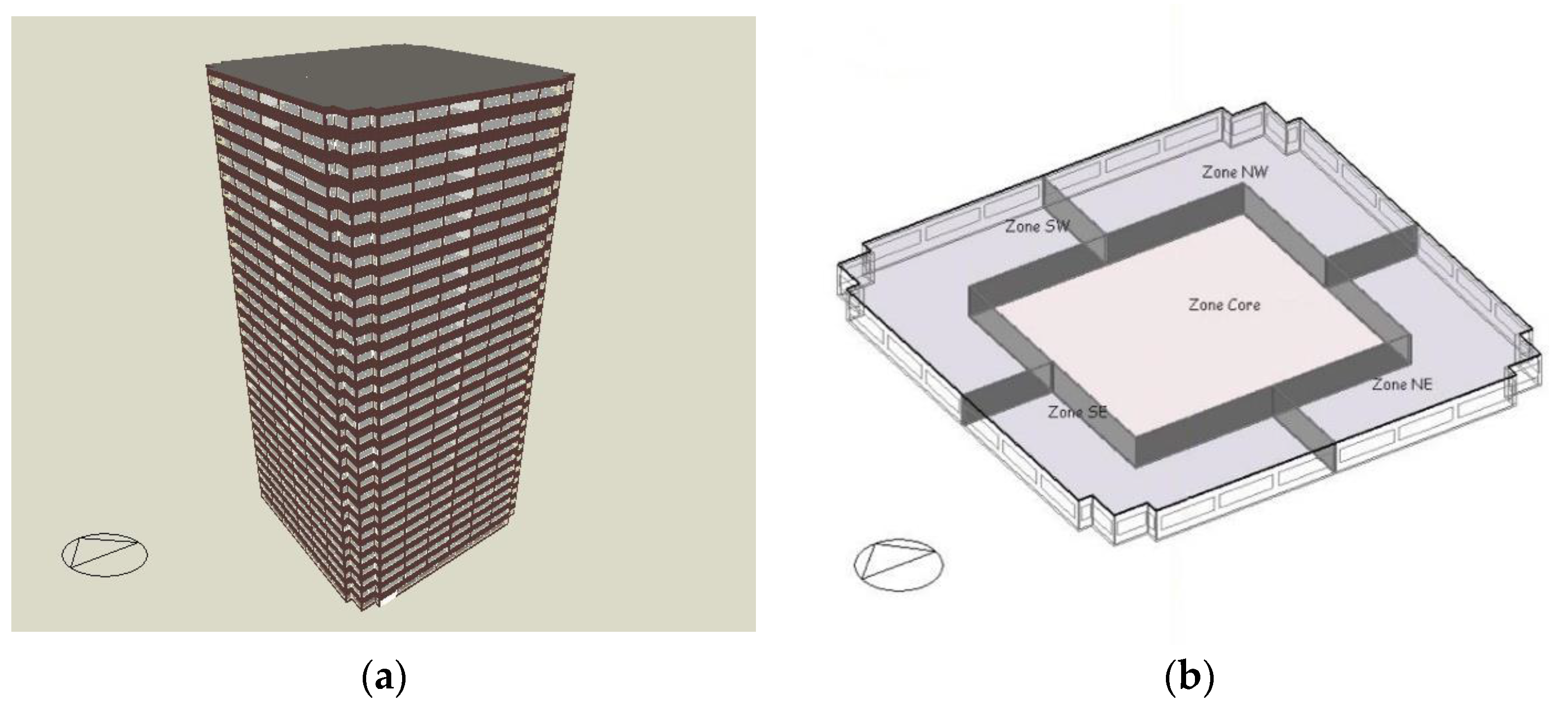

References
- Foucquier, A.; Robert, S.; Suard, F.; Stéphan, L.; Jay, A. State of the art in building modelling and energy performances prediction: A review. Renew. Sustain. Energy Rev. 2013, 23, 272–288. [Google Scholar] [CrossRef]
- Zhang, Y.; O’Neill, Z.; Dong, B.; Augenbroe, G. Comparisons of inverse modeling approaches for predicting building energy performance. Build. Environ. 2015, 86, 177–190. [Google Scholar] [CrossRef]
- ASHRAE. 2013 ASHRAE Handbook—Fundamentals (SI Edition); American Society of Heating, Refrigerating and Air Conditioning Engineers (ASHRAE): Atlanta, GA, USA, 2013. [Google Scholar]
- Zeng, A.; Liu, S.; Yu, Y. Comparative study of data driven methods in building electricity use prediction. Energy Build. 2019, 194, 289–300. [Google Scholar] [CrossRef]
- ANSI/ASHRAE/IES Standard 90.1-2013; Energy Standard for Buildings Except Low-Rise Residential Buildings. ASHRAE Standard: Peachtree Corners, GA, USA, 2013.
- Amasyali, K.; El-Gohary, N.M. A review of data-driven building energy consumption prediction studies. Renew. Sustain. Energy Rev. 2018, 81, 1192–1205. [Google Scholar] [CrossRef]
- Amiri, S.S.; Mottahedi, M.; Asadi, S. Using multiple regression analysis to develop energy consumption indicators for commercial buildings in the U.S. Energy Build. 2015, 109, 209–216. [Google Scholar] [CrossRef]
- Wang, Z.; Wang, Y.; Srinivasan, R.S. A novel ensemble learning approach to support building energy use prediction. Energy Build. 2018, 159, 109–122. [Google Scholar] [CrossRef]
- Platon, R.; Dehkordi, V.R.; Martel, J. Hourly prediction of a building’s electricity consumption using case-based reasoning, artificial neural networks and principal component analysis. Energy Build. 2015, 92, 10–18. [Google Scholar] [CrossRef]
- Yan, L.; Liu, M. A simplified prediction model for energy use of air conditioner in residential buildings based on monitoring data from the cloud platform. Sustain. Cities Soc. 2020, 60, 102194. [Google Scholar] [CrossRef]
- Zhang, L.; Wen, J. A systematic feature selection procedure for short-term data-driven building energy forecasting model development. Energy Build. 2019, 183, 428–442. [Google Scholar] [CrossRef]
- González-Vidal, A.; Jiménez, F.; Gómez-Skarmeta, A.F. A methodology for energy multivariate time series forecasting in smart buildings based on feature selection. Energy Build. 2019, 196, 71–82. [Google Scholar] [CrossRef]
- Pistore, L.; Pernigotto, G.; Cappelletti, F.; Gasparella, A.; Romagnoni, P. A stepwise approach integrating feature selection, regression techniques and cluster analysis to identify primary retrofit interventions on large stocks of buildings. Sustain. Cities Soc. 2019, 47, 101438. [Google Scholar] [CrossRef]
- Ahmad, T.; Zhang, H. Novel deep supervised ML models with feature selection approach for large-scale utilities and buildings short and medium-term load requirement forecasts. Energy 2020, 209, 118477. [Google Scholar] [CrossRef]
- Fan, C.; Xiao, F.; Wang, S. Development of prediction models for next-day building energy consumption and peak power demand using data mining techniques. Appl. Energy 2014, 127, 1–10. [Google Scholar] [CrossRef]
- Zhang, C.; Cao, L.; Romagnoli, A. On the feature engineering of building energy data mining. Sustain. Cities Soc. 2018, 39, 508–518. [Google Scholar] [CrossRef]
- Iguyon, I.; Elisseeff, A. An introduction to variable and feature selection. J. Mach. Learn. Res. 2003, 3, 1157–1182. [Google Scholar] [CrossRef][Green Version]
- Liu, H.; Motoda, H.; Setiono, R.; Zhao, Z. Feature Selection: An Ever Evolving Frontier in Data Mining. In Proceedings of the Workshop and Conference Proceedings 10: Fourth Workshop on Feature Selection in Data Mining, Hyderabad, India, 21 June 2010; Volume 10, pp. 4–13. [Google Scholar]
- János, V.Z.; Kis, K.B.; Fodor, Á.; Büki, Á.M. Adaptive, Hybrid Feature Selection (AHFS). Pattern Recognit. 2021, 116, 107932. [Google Scholar] [CrossRef]
- Odhiambo Omuya, E.; Onyango Okeyo, G.; Waema Kimwele, M. Feature Selection for Classification using Principal Component Analysis and Information Gain. Expert Syst. Appl. 2021, 174, 114765. [Google Scholar] [CrossRef]
- Antonucci, D.; Filippi Oberegger, U.F.; Pasut, W.; Gasparella, A. Building performance evaluation through a novel feature selection algorithm for automated arx model identification procedures. Energy Build. 2017, 150, 432–446. [Google Scholar] [CrossRef]
- Zhu, M.; Pan, Y.; Huang, Z. A Hybrid Space Filling Design Method of Building Performance Database Construction for Office. In Proceedings of the ASim 2018—4th Asia Conference of International Building Performance Simulation Association, Hong Kong, China, 3–5 December 2018. [Google Scholar]
- Zhao, J.; Plagge, R.; Ramos, N.M.M.; Simões, M.L.; Grunewald, J. Concept for development of stochastic databases for building performance simulation—A material database pilot project. Build. Environ. 2015, 84, 189–203. [Google Scholar] [CrossRef]
- Dipasquale, C.; Fedrizzi, R.; Bellini, A.; Gustafsson, M.; Ochs, F.; Bales, C. Database of energy, environmental and economic indicators of renovation packages for European residential buildings. Energy Build. 2019, 203, 109427. [Google Scholar] [CrossRef]
- Chen, Y.; Deng, Z.; Hong, T. Automatic and rapid calibration of urban building energy models by learning from energy performance database. Appl. Energy 2020, 277, 115584. [Google Scholar] [CrossRef]
- Gui, X.; Gou, Z. Association between green building certification level and post-occupancy performance: Database analysis of the National Australian Built Environment Rating System. Build. Environ. 2020, 179, 106971. [Google Scholar] [CrossRef]
- Mathew, P.A.; Dunn, L.N.; Sohn, M.D.; Mercado, A.; Custudio, C.; Walter, T. Big-data for building energy performance: Lessons from assembling a very large national database of building energy use. Appl. Energy 2015, 140, 85–93. [Google Scholar] [CrossRef]
- Kim, D.W.; Kim, Y.M.; Lee, S.E. Development of an energy benchmarking database based on cost-effective energy performance indicators: Case study on public buildings in South Korea. Energy Build. 2019, 191, 104–116. [Google Scholar] [CrossRef]
- Walter, T.; Sohn, M.D. A regression-based approach to estimating retrofit savings using the Building Performance Database. Appl. Energy 2016, 179, 996–1005. [Google Scholar] [CrossRef]
- U.S. Department Energy. Commercial Buildings Energy Consumption Survey. 2018. Available online: https://www.eia.gov/cbecs (accessed on 1 October 2022).
- Alstone, P.; Potter, J.; Piette, M.A. 2025 California Demand Response Potential Study—Charting California’s Demand Response Future: Final Report on Phase 2 Results; Lawrence Berkeley National Lab. (LBNL): Berkeley, CA, USA, 2017; Volume LBNL-20011.
- Yin, R.; Ghatikar, G.; Piette, M.A. Big-Data Analytics for Electric Grid and Demand-Side Management; Lawrence Berkeley National Lab. (LBNL): Berkeley, CA, USA, 2019.
- Berry, C.; Lawson, G.; Woodward, M. Highlights from the 2015 RECS: Energy Consumption, Expenditures, and End-Use Modeling; U.S. Energy Information Administration: Washington, DC, USA, 2018.
- Lee, S.H.; Hong, T.; Piette, M.A.; Sawaya, G.; Chen, Y.; Taylor-Lange, S.C. Accelerating the energy retrofit of commercial buildings using a database of energy efficiency performance. Energy 2015, 90, 738–747. [Google Scholar] [CrossRef]
- Mao, J.; Pan, Y.; Fu, Y. Towards fast energy performance evaluation: A pilot study for office buildings. Energy Build. 2016, 121, 104–113. [Google Scholar] [CrossRef]
- Kim, Y.J.; Yoon, S.H.; Park, C.S. Stochastic comparison between simplified energy calculation and dynamic simulation. Energy Build. 2013, 64, 332–342. [Google Scholar] [CrossRef]
- Li, W.; Huang, Y. A combined method of cross-correlation and PCA-based outlier algorithm for detecting structural damages on a jacket oil platform under random wave excitations. Appl. Ocean. Res. 2020, 102, 102301. [Google Scholar] [CrossRef]
- Peng, H.; Long, F.; Ding, C. Feature selection based on mutual information: Criteria of Max-Dependency, Max-Relevance, and Min-Redundancy. IEEE Trans. Pattern Anal. Mach. Intell. 2005, 27, 1226–1238. [Google Scholar] [CrossRef]
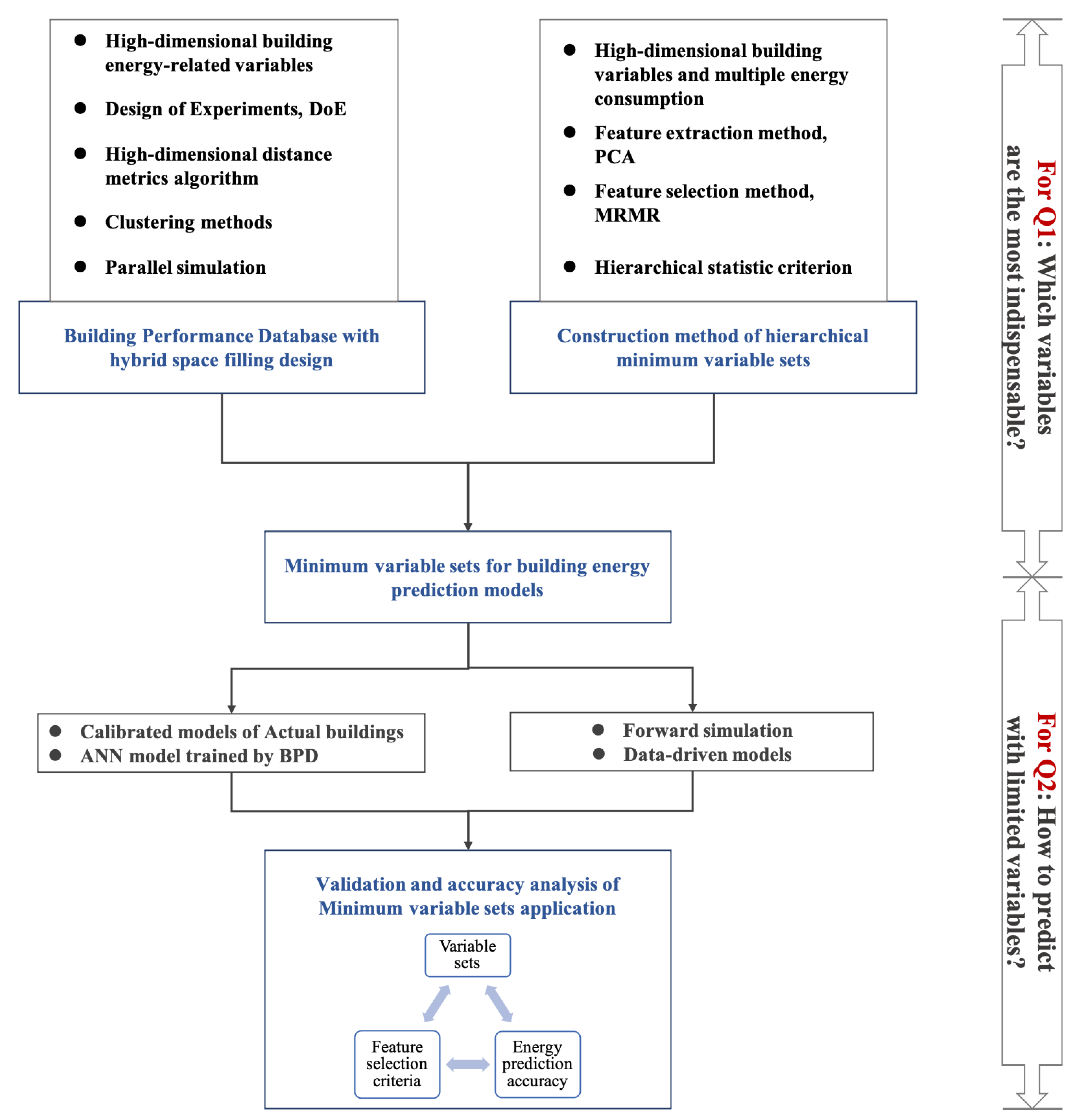
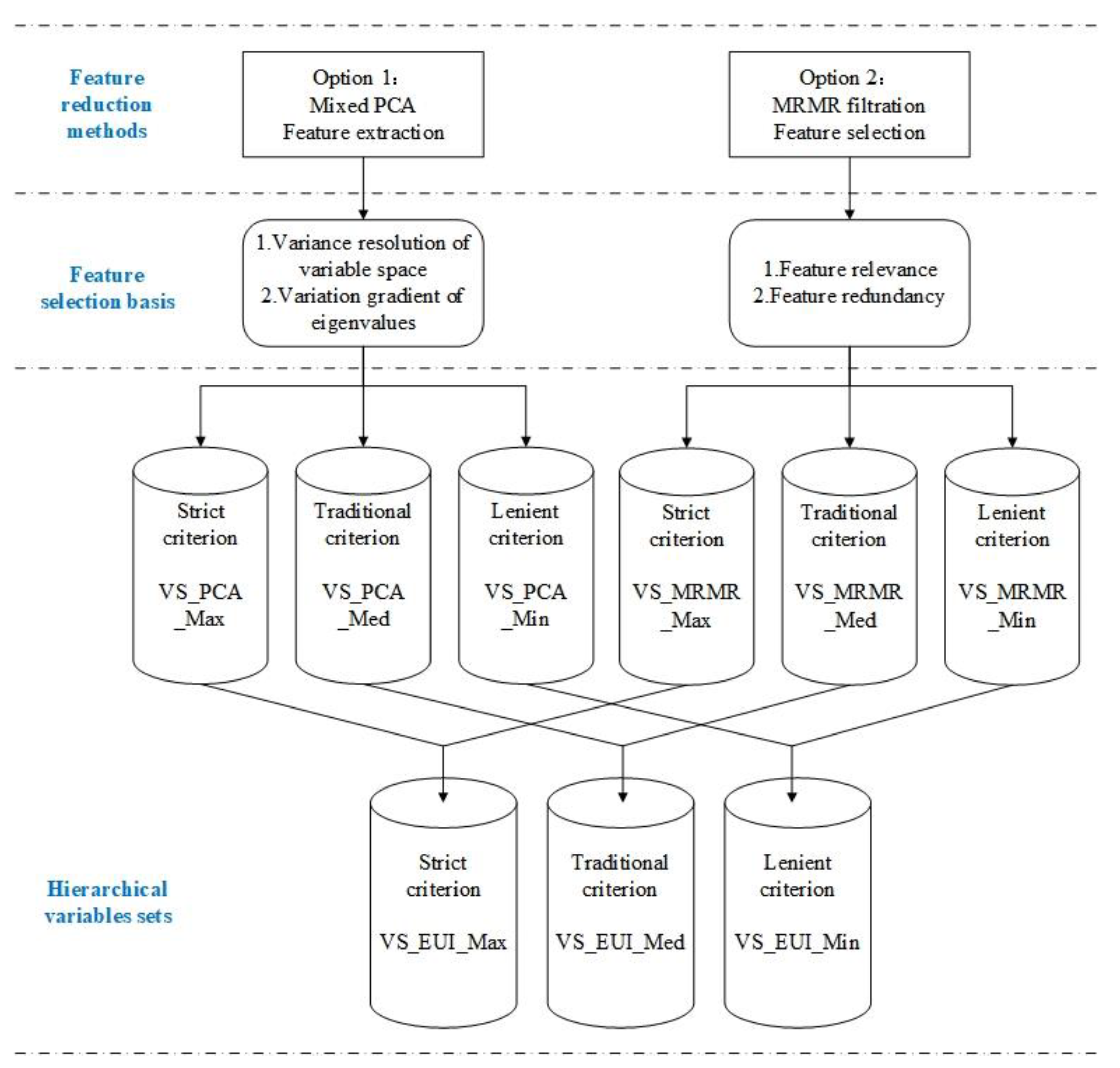
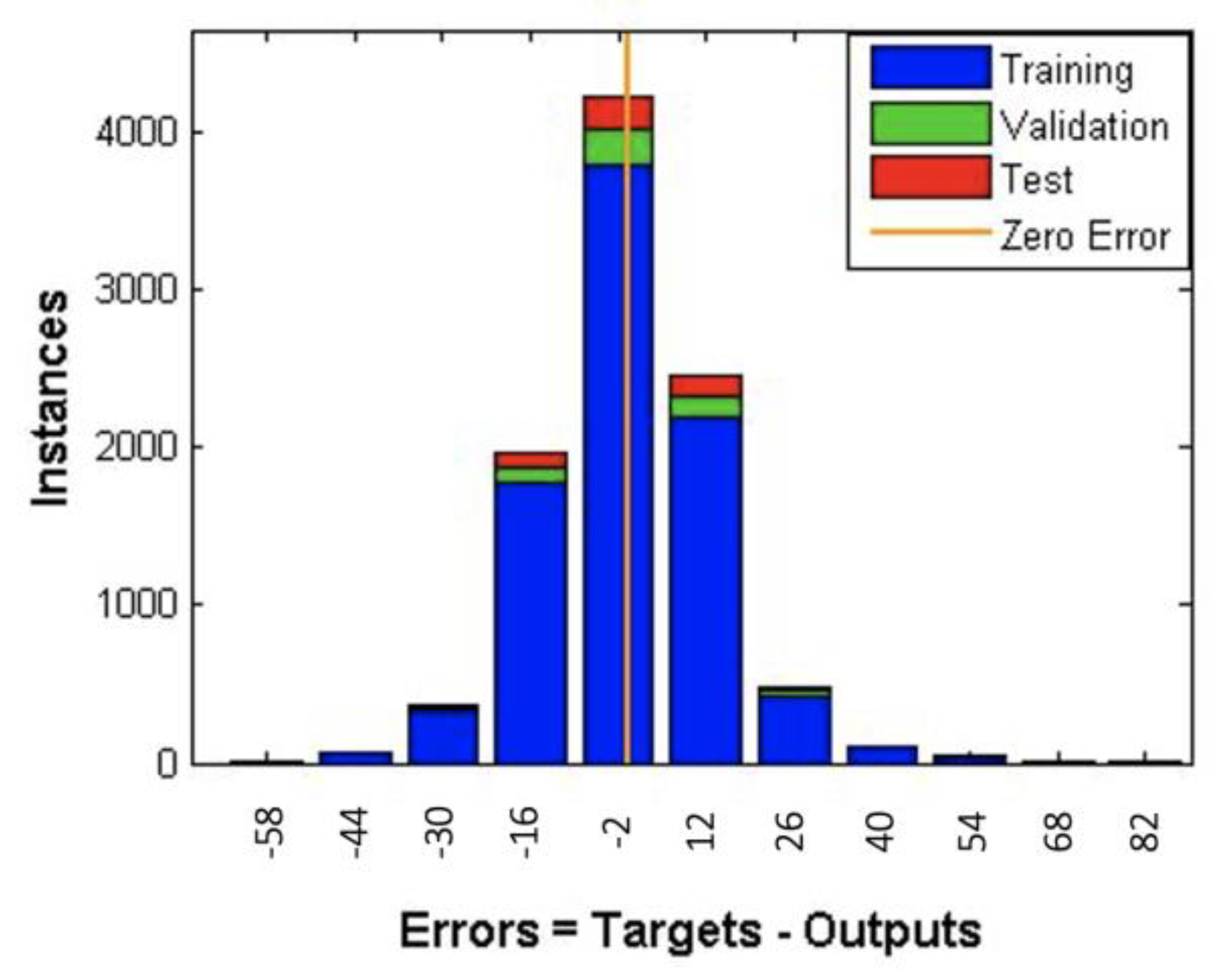
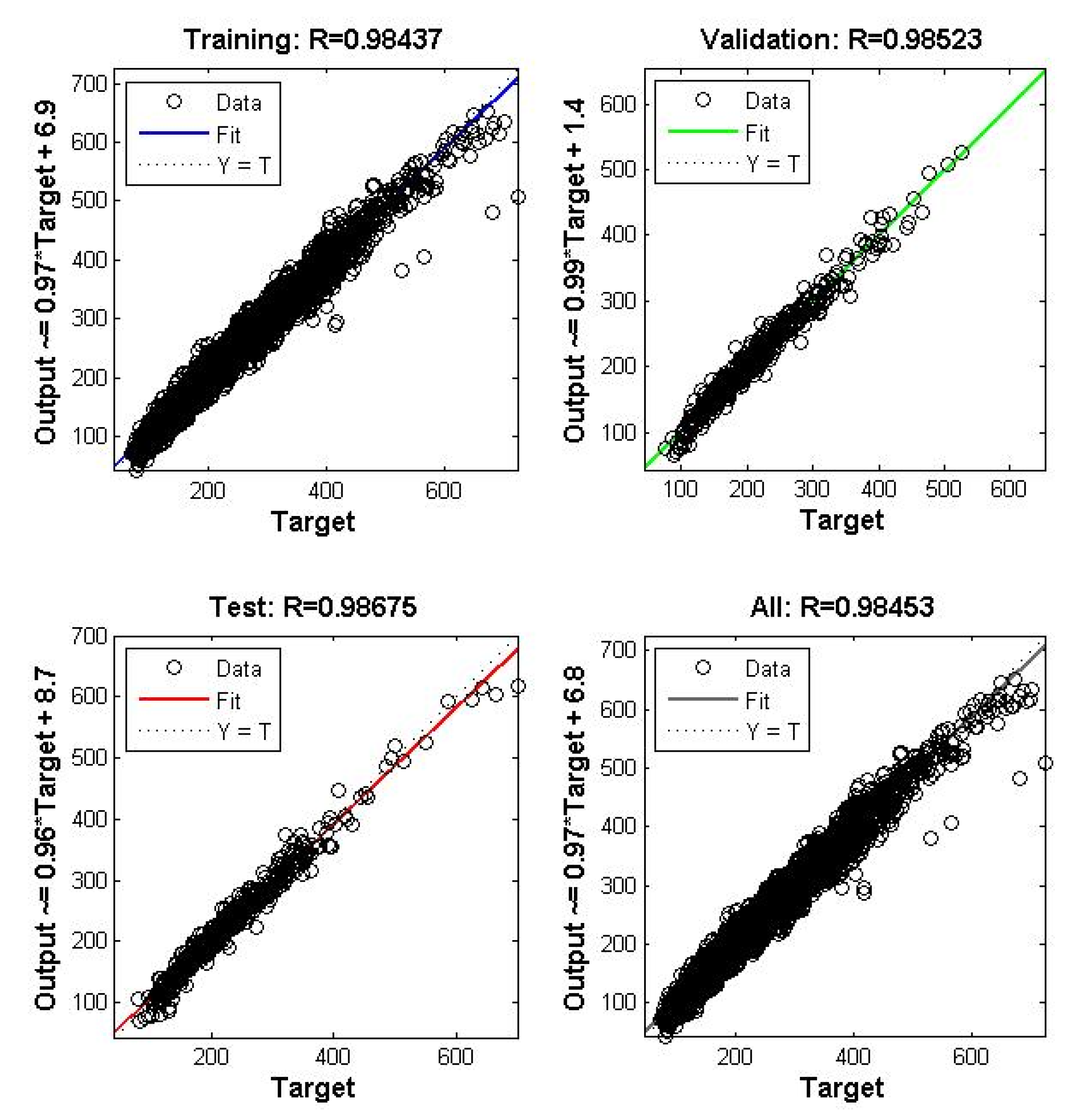
| Numerical Variable | Description | Range | Non-Numerical Variable | Description | Range |
|---|---|---|---|---|---|
| v1_sat | Summer average temperature/°C | 16.0~31.0 | v13_HVAC | All zones: CAV | A0 |
| v2_wat | Winter average temperature/°C | −11.0~23.2 | All zones: VAV | A1 | |
| v3_tat | Transition average temperature/°C | 4.5~24.9 | All zones: FCU + OA | A2 | |
| v4_sarh | Summer average relative humidity | 0.28~0.88 | Core: VAV Perimeter: FCU + OA | A3 | |
| v5_bsc | Building shape coefficient | 0.10~0.50 | All zones: VRV | A4 | |
| v6_wwr | Window/wall ratio | 0.10~1.00 | v14_plant | CentiChiller and boiler | P0 |
| v7_ohtc | Overall heat transfer coefficient, OHTC, w/m2 | 5.0~35.0 | Screw chiller and boiler | P1 | |
| v8_lpd | Lighting power density, w/m2 | 10.0~20.0 | Absorption chiller and boiler | P2 | |
| v9_ppd | People power density, m2/p | 2.0~10.0 | Ground-source heat pump | P3 | |
| v10_epd | Equipment power density, w/m2 | 10.0~20.0 | Air-source heat pump | P4 | |
| v11_sidt | Summer indoor design temperature/°C | 22.0~28.0 | CentiChiller and heat pump | P5 | |
| v12_widt | Winter indoor design temperature/°C | 15.0~22.0 | v15_tspt | Variable speed pumps | Y/N |
| v16_schd | Operation schedules | High/Std/Low usage |
| MVS | VS_EUI_Max | VS_EUI_Med | VS_EUI_Min |
|---|---|---|---|
| Included variables | v13_HVAC v14_plant v15_trsp v1_sat v2_wat v3_tat v5_bsc v16_schd v9_ppd v6_wwr v11_sidt v8_lpd | v13_HVAC v1_sat v2_wat v5_bsc v16_schd v9_ppd v6_wwr v11_sidt v8_lpd | v13_HVAC v1_sat v2_wat v5_bsc v16_schd v9_ppd v6_wwr |
| Variable number | 12 | 9 | 7 |
| i = 1 | i = 2 | i = 3 | |
| 6~9% | 8~11% | 14~17% |
| Key Setting | Description |
|---|---|
| Training function | Levenberg–Marquardt BP algorithm |
| Hidden layer transfer/excitation functions | Sigmoid function |
| Output layer transfer/excitation functions | Linear function |
| Number of nodes in hidden layer | |
| Dataset partition | Random sampling, with 90% (8774 cases) as training set, 5% (488 cases) as validation set, 5% (488 cases) as test set |
| Model evaluation index to end the training | Mean Square Error (MSE) |
| Model Results of BP_Mi | i = 1 | i = 2 | i = 3 |
| 12 | 9 | 7 | |
| to training/test set | 0.95~0.98 | 0.82~0.87 | 0.82~0.85 |
| for office 1 in Shanghai | 1~11% | 9~15% | 13~24% |
| for office 1 in Shanghai | 5.8% | 8.9% | 15.0% |
| for office 2 in California | 5~11% | 19~25% | 20~32% |
| for office 2 in California | 8.6% | 20.9% | 23.1% |
| Model results of | 6~9% | 8~11% | 14~17% |
Publisher’s Note: MDPI stays neutral with regard to jurisdictional claims in published maps and institutional affiliations. |
© 2022 by the authors. Licensee MDPI, Basel, Switzerland. This article is an open access article distributed under the terms and conditions of the Creative Commons Attribution (CC BY) license (https://creativecommons.org/licenses/by/4.0/).
Share and Cite
Zhu, M.; Pan, Y.; Lyu, Y.; Huang, Z.; Li, P. A New Explication of Minimum Variable Sets (MVS) for Building Energy Prediction Based on Building Performance Database. Buildings 2022, 12, 1907. https://doi.org/10.3390/buildings12111907
Zhu M, Pan Y, Lyu Y, Huang Z, Li P. A New Explication of Minimum Variable Sets (MVS) for Building Energy Prediction Based on Building Performance Database. Buildings. 2022; 12(11):1907. https://doi.org/10.3390/buildings12111907
Chicago/Turabian StyleZhu, Mingya, Yiqun Pan, Yan Lyu, Zhizhong Huang, and Pengcheng Li. 2022. "A New Explication of Minimum Variable Sets (MVS) for Building Energy Prediction Based on Building Performance Database" Buildings 12, no. 11: 1907. https://doi.org/10.3390/buildings12111907
APA StyleZhu, M., Pan, Y., Lyu, Y., Huang, Z., & Li, P. (2022). A New Explication of Minimum Variable Sets (MVS) for Building Energy Prediction Based on Building Performance Database. Buildings, 12(11), 1907. https://doi.org/10.3390/buildings12111907






